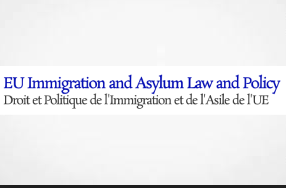23 October 2024
POST 23 OF THE SERIES OF THE ODYSSEUS BLOG ON THE PACT ON MIGRATION & ASYLUM
By Professor Elspeth Guild, University of Liverpool and Vasiliki Apatzidou, Queen Mary University of London
EU law in the field of asylum and protection of refugees has undergone dramatic changes in the first quarter of 2024. The legislator has agreed a new set of EU instruments which cover all areas from arrival on the territory to reception, treatment of claims, rights of those in need of international protection and expulsion of those determined not to need it. Collectively, this set of new instruments constitutes the 3rd phase of the Common European Asylum System (CEAS) replacing the 2nd phase instruments adopted in 2013. Moving towards the implementation phase, EU States must ensure that their practices are consistent with human rights standards. This issue is the subject of a recent report by the Swedish Institute for European Policy Studies. We will not repeat its contents here. Our objective is to offer a concise yet insightful examination of four key areas in the new CEAS instruments which may have human rights implications: access to the territory, access to a fair procedure, detention and reception conditions including family unity. The aim is to provide a broad understanding of these areas highlighting overarching human rights concerns.
Sources of Human Rights Protection
The new instruments straddle three different regimes of legal responsibility. The first is the state sovereignty claim to control its borders and determine those aliens who may enter. The EU instruments modify this exercise of state sovereignty by providing rules which are binding on the Member States. The form of these rules in EU law is now directly applicable regulations with the exception of the Reception Conditions Directive (RCD). These new instruments are all subject to and must be applied consistently with the EU Charter of Fundamental Rights.
The second regime is that of European human rights law. The European Convention on Human Rights (ECHR) is applicable to all EU states and incorporated into the TEU. The ECHR does not contain any provisions which explicitly mention refugees or asylum. However, through the jurisprudence of the ECtHR, many provisions are relevant to the reception and treatment of people seeking international protection, most importantly the principle of non-refoulement on which the other obligations are built. Further, at least one other Council of Europe convention ratified by the EU has been found by the EU’s Court of Justice (ECJ) to be relevant to asylum applications.
The third regime is international refugee and human rights law contained in conventions adopted by the UN and ratified by the Member States and (in some cases) the EU. The Refugee Convention (and its protocol) are key among these instruments and referred to in the TFEU and the EU Charter. There are nine core human rights conventions in this category (with many protocols) all of which are relevant to the treatment of people seeking international protection with two of them setting out an express non-refoulement requirement. The application of these conventions extends to all individuals within a state’s jurisdiction or control.
Access to Territory
The standards that states must uphold concerning protection seekers’ access to territory entail the obligation not to send individuals to places where they face grave risks such as persecution, torture, or other forms of inhuman treatment. This principle, known as non-refoulement, is widely recognised at the international, regional, and national levels. This means that every state which is a party to any of the conventions in which a non-refoulement duty is included (directly or indirectly) must carry out an assessment of the protection claim before taking action to remove the individual from its territory. This principle is not only foreseen in international law (customary international law and treaty law), but the ECtHR has many times relied on Articles 2 and 3 ECHR to find violations of this principle. Further, the EU Charter contains provisions which are relevant to non-refoulement (Articles 4, 18 and 19). However, the implementation of the new instruments may present significant challenges to this principle.
Primarily, the Screening Regulation although it describes a procedure which is not new as such, yet it brings a novelty which concerns the outcome of this procedure (mentioned as ‘completion of the screening’). While identification procedures previously conducted in ‘hotspots’ in Greece and Italy primarily served to collect and register data of third-country nationals, under this Regulation, these procedures will also be used to determine whether they should be directed to asylum or return procedures. Additionally, the decision will specify which asylum procedure, regular or border, should be followed (Article 18 Screening Regulation). Consequently, the outcome of the screening process can impact individuals’ rights and their protection from refoulement.
Despite its profound implications, the decision resulting from the screening process will be a ‘screening form’ rather than a formal administrative decision. According to Article 17 Screening Regulation, the information in the screening form shall be recorded in such a way that it is amenable to administrative and judicial review ‘during any ensuing asylum or return procedure’. Hence, the ‘screening form’ should be incorporated in an administrative act to be subject to legal remedy. This approach may lead to a possible violation of the right to an effective remedy and subsequently to refoulement.
Further, uncertainty surrounds whether third-country nationals undergoing the screening process will have access to legal assistance, as these procedures will usually take place at external border locations and in detention. Legal assistance is crucial for accurately recording their asylum claim and preventing refoulement. In the Regulation, there is no mention of legal assistance, only the right of organisations and persons providing advice to have access to third-country nationals during screening (Article 8 (6) Screening Regulation).
We appreciate the introduction of Article 3, emphasising compliance with relevant Union and international laws, including the principle of non-refoulement as well as the introduction of a monitoring mechanism regarding compliance of screening procedures with fundamental rights (Article 10 Screening Regulation). However, compliance with these minimum standards may in practice prove challenging due to the ‘non-entry’ fiction maintained in the final text (Article 6 Screening Regulation), which means that third-country nationals physically present in the territory will be treated as ‘not-entered’, justifying diminished procedural protections and preventing access to the full set of rights associated with legal entry.
Access to the Asylum Procedure
Ensuring protection from refoulement hinges on granting asylum-seekers timely access to quality asylum procedures. Like access to territory, access to the asylum procedure is an essential condition for effective refugee and human rights protection. The right to access to a procedure is implicit in the prohibition of refoulement. Although refugee status is declaratory, protection from refoulement requires a procedure to determine whether there is a risk of persecution or other ill-treatment in the country of return. Procedural rules are inherent to substantive rights, hence this part delves into the critical aspects of the asylum procedure, exploring how the new regulations may pose challenges to the right to access asylum.
Firstly, states have an obligation to promptly register asylum claims by recording applicants’ personal details and reasons for their claims and to treat them as ‘asylum seekers’ from the moment they express their intention to apply for asylum.. However, the Screening Regulation requires that access to registration and asylum procedures is contingent upon the completion of the screening process, which should ideally be finalised within 7 days. At least, Article 4 of the Regulation clarifies that third-country nationals who have made an application for international protection during screening are still entitled to certain rights. Specifically, the registration of their asylum application follows the rules laid out in Article 27 of Regulation (EU) 2024/1348 (Asylum Procedures Regulation), and the application of reception conditions is governed by Article 3 of Directive (EU) 2024/1346 (Reception Conditions Directive). Consequently, while individuals undergoing screening are not immediately classified as ‘asylum seekers’, certain protections under asylum law still apply during the screening process.
Even if individuals manage to access the asylum system post-screening, they may be directed to asylum border procedures, which offer lower procedural guarantees. Border procedures are mainstreamed in the new Asylum Procedures Regulation (APR) and even become obligatory in some cases (Articles 45 APR). The most problematic issue is the third criterion which mandates the use of border procedure based on the recognition rates of countries of origin. Both accelerated (Article 42 APR) and border procedures become mandatory for asylum-seekers coming from countries of origin with a recognition rate of 20% or lower, according to the latest available Eurostat data. This nationality-based criterion influences the extent of procedural rights accorded to applicants which may seriously impact the principle of non-discrimination.
Additionally, the APR extends the concept of ‘safe third country’, which can be decided on the basis of a national list, EU list or no list at all (Articles 59-60 APR). Applicants coming from ‘safe countries’ will usually have to undergo accelerated, border, and inadmissibility procedures which are super-fast sub-standard procedures which hinder access to quality asylum procedures, efficient determination of the claim and protection from refoulement. Moreover, asylum-seekers in border procedures are subject to the ‘non-entry’ fiction, further legitimising exceptions from procedural protections.
For instance, access to legal assistance may be restricted in accelerated and border procedures due to the locations where these procedures take place (detention or de facto detention). While the European Parliament advocated for expanded legal aid, Member States insisted on providing only free legal counselling for the administrative procedure (Article 16 APR), while free legal representation will be available only at the stage of the appeal.
Moreover, ensuring access to asylum procedures entails considering applicants with special procedural needs, as vulnerabilities may affect an individual’s ability to participate in the asylum process. While the Screening Regulation mandates a vulnerability check, its completion within 7 days, especially during mass arrivals, remains uncertain. Even if identified as vulnerable, applicants may still be subject to border procedures, as vulnerability does not exempt them from these procedures (Article 53 APR).
Also, in case of rejection, applicants should have the right to an appeal. However, in accelerated and border procedures, the lack of sufficient time to prepare and lodge an appeal negates the guarantee to an effective remedy, particularly for asylum-seekers whose rejection decisions do not grant suspensive effect (Article 68 APR).
Finally, the diminished standards of border procedures may apply to applicants from countries of origin with a recognition rate of 50% or lower in cases of ‘crisis’ (Article 11 (4) Crisis Regulation). In situations of ‘instrumentalisation’, all applications may be subjected to border procedures (Article 11(6) Crisis Regulation). Consequently, access to asylum and a proper procedure may be seriously compromised in such situations.
Detention
The agreed instruments introduce provisions allowing for detention or movement restrictions for applicants for international protection at various stages of the asylum procedure , raising significant concerns about their compliance with international standards on detention and freedom of movement. The new provisions must be interpreted in accordance with international obligations and EU primary law.
It is essential to note the general presumption against detention in international law, where detention is permissible only under strictly defined circumstances (e.g. in Article 9(1) of the International Covenant on Civil and Political Rights). For detention to be non-arbitrary, it must be lawful, pursue a legitimate aim, and be necessary, reasonable, and proportionate. Similar to international law, EU primary law also mandates that detention must be proportionate and necessary according to the ECJ. The ECtHR has also many times ruled on border crossing and detention under Article 5 (1) (f). In the case-law of the ECtHR, the principles of necessity and proportionality are compromised when detention is imposed to prevent unauthorised entry. However, such decisions (Ilias Ahmed v Hungary and Saadi v UK) must also be implemented consistently with UN principles and guidelines, and the jurisprudence of the Human Rights Committee (HRC).
The RCD regulates detention and movement restrictions in the new Pact. While Article 10 outlines reasons for detention, many of which are already present in the current Directive, particularly troubling is the legitimisation of movement restrictions within the new framework. The practice of allocating asylum seekers to specific geographical areas or restricting their movement to designated places (Articles 8 and 9 RCD), poses serious questions about the true intent behind such measures. Despite being framed as necessary for efficient asylum processing or prevention of absconding, these restrictions may effectively amount to de facto detention. This is especially problematic when coupled with the conditionality of receiving material reception conditions only if one remains in the designated area.
Moreover, the emphasis on the establishment of a ‘pre-entry phase’ at the external borders exacerbates concerns, as border procedures often take place in detention or de facto detention settings. The legislation’s vagueness regarding the location where border procedures may occur and the lack of clarity on necessary accommodation for asylum seekers during these procedures suggest that de facto detention may become a routine practice mainly due to the ‘non-entry’ fiction as asylum seekers in border procedures should be prevented from (legally) entering the territory. This means that restriction on the freedom of movement may be automatically imposed in the context of border procedures based on a generic rule, without an individual assessment (Article 9 RCD). Additionally, the RCD explicitly allows detention in the context of border procedures (Article 10 (4) d RCD). However, in such cases, detention cannot be imposed automatically and a necessity and proportionality assessment should always be conducted.
Similar concerns arise in the Screening Regulation, where it is mentioned that states are ‘required to apply measures [..] to prevent the persons concerned from entering the territory during the screening’ effectively leading to a form of detention or at least a restriction on the freedom of movement. Additionally, return border procedures include a specific provision on detention (Article 5), justifying detention for individuals rejected in the context of a border procedure.
Further, the Crisis Regulation allows for the extension of the registration period, the asylum border procedures (Articles 10, 11 Crisis Regulation) and the return border procedures (Article 6 Return Border Procedures Regulation) which also may result in longer periods of deprivation of liberty or movement restrictions in cases of mass arrivals or ‘instrumentalisation’.
These provisions raise concerns about potential violations of personal liberty under international human rights frameworks, as there is a notable lack of clarity within the Pact regarding the distinction between detention and constraints on freedom of movement. To ensure compliance, decisions on non-entry policies must explicitly delineate whether they constitute detention or limitations on movement, supported by individual assessments and necessity and proportionality justifications. Additionally, administrative decisions should undergo judicial review, granting the judiciary authority to assess legality and potentially overturn administrative decisions.
Reception Conditions including family unity
There are two key standards regarding reception conditions for those seeking international protection in the ECHR and international human rights conventions. The first is that the treatment of any person under the control or jurisdiction of a state must not constitute torture, inhuman or degrading treatment. Where those seeking international protection are not permitted to work to fulfil their needs, and when there are restrictions on their liberty, states must ensure for them conditions of reception which do not fall below this standard. This includes accommodation, living conditions, access to clean water and nutritious food, health care and the identification and protection of those who are in situations of vulnerability.
The second standard is that of non-discrimination on prohibited grounds in the access to goods and services, including social benefits. This standard has been the subject of increasing scrutiny by the Committee on Economic, Social and Cultural Rights (See General Comment 20). Both standards may also include issues of family unity.
The revisions made to the RCD include a new Article 7 on organisation of reception conditions. This provision leaves substantial leeway to Member States on how to deliver reception. It permits many limitations on reception and possible conditions which may be placed on those seeking international protection. Further, it specifically states that state actions do not require the adoption of an administrative decision (thereby preventing appeals). Article 17 requires States to allow asylum seekers access to the labour market at least six months after their claims. However, the provision permits states to exclude equal treatment in social security benefits (Article 17(6)) which may not be compatible with international standards.
Articles 19 and 22 relate to health care and set out how States may choose to provide healthcare. But this includes ways which are discriminatory against those seeking international protection in comparison with their own nationals of the state. The General Comments of the (UN) Committee on Economic, Social and Cultural Rights require the principle of non-discrimination to be respected. This does not mean that in all cases aliens and citizens must be treated in the same manner, but any difference of treatment must be necessary, proportionate and justified to be consistent with the ICESCR. The interpretation of the ECHR by the ECtHR adopts a similar approach, but also accepts that there may be circumstances where the situations of aliens and citizens are so different that they are not comparable. The CJEU has adopted a similar approach. It should be noted that the differences in approach between the ESC Committee, the ECtHR and the CJEU do not mean that states are free to choose which regime they approve. Where they have, through ratification of a treaty, consented to be bound, they must comply with all the obligations as separate and cumulative commitments.
Articles 20 and 21 relate to material reception conditions. The power to provide differential reception conditions to those seeking international protection whose applications will be considered in the state where they are resident and those who (in theory) will have their applications dealt with in another Member State is problematic. This appears to constitute discrimination on grounds which may not be consistent with international standards. In the case of withdrawal of reception conditions for failures on the part of the individual, the directive specifically references the need to comply with international human rights standards. It would be advisable for States to use this requirement across the board in considering the level of reception conditions, not merely decision on withdrawal.
Article 27 deals with the situations of unaccompanied minors and the question of age assessments. It is a sad truth that there are examples of Member States making erroneous age assessments which result in the classification of minors as adults resulting in the immediate loss of the specific benefits designed to protect children. State implementation of this provision must take into account international standards on age assessments.
Article 2(3) defines family members as including only those persons who were family members before the asylum seeker arrived on the territory of the Member State. The class is limited to spouses and unmarried partners (where permitted under national law) and minors or dependent children, who must be unmarried. For unaccompanied minors, the definition includes only parents or responsible adults which can include siblings. This definition is then applied to the provision of reception conditions for families. While there is no single definition of a family in international law, a number of Treaty Bodies have addressed the issue preferring a flexible meaning to respect the dignity of the people involved whose legal and cultural obligations to relatives. But the principle of non-discrimination with own nationals has been a useful tool in assisting to determine these relationships and the extent to which states protect them. In many Member States adult children are legally responsible for the welfare of their parents. As this standard of family duty is applicable to nationals it may be wise also to reflect this in the treatment of family unity for those seeking international protection.
Conclusions
In this blog we have highlighted some of what we see as the key issues regarding EU and Member States obligations to all persons under their control (or jurisdiction) which arise as in the context of the new CEAS instruments. Our purpose here is to examine some of the issues which have received substantial attention or which we have identified as problematic. We recommend that Member States take great care when establishing their practices under the new instruments to ensure that each one is compliant with all three regimes applicable to the treatment of those seeking international protection.






